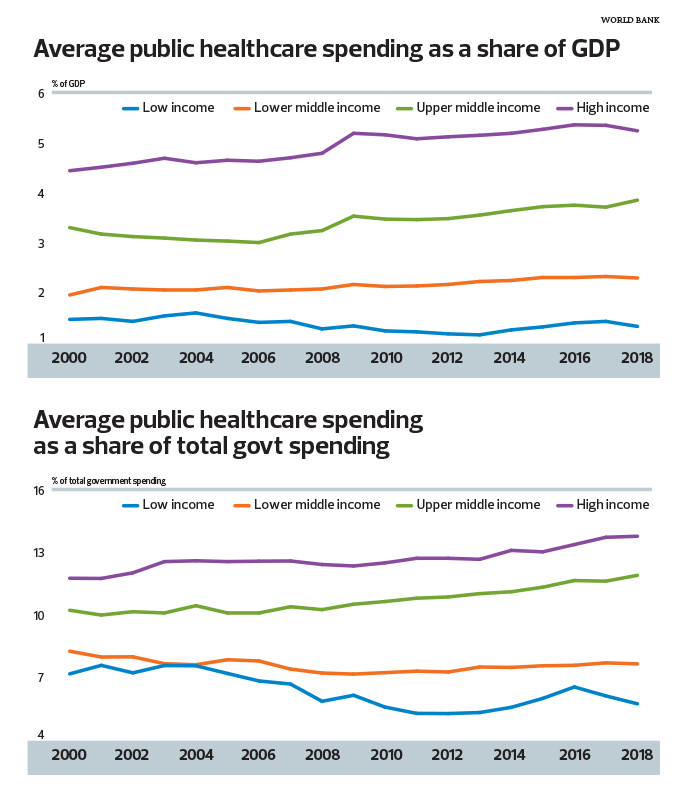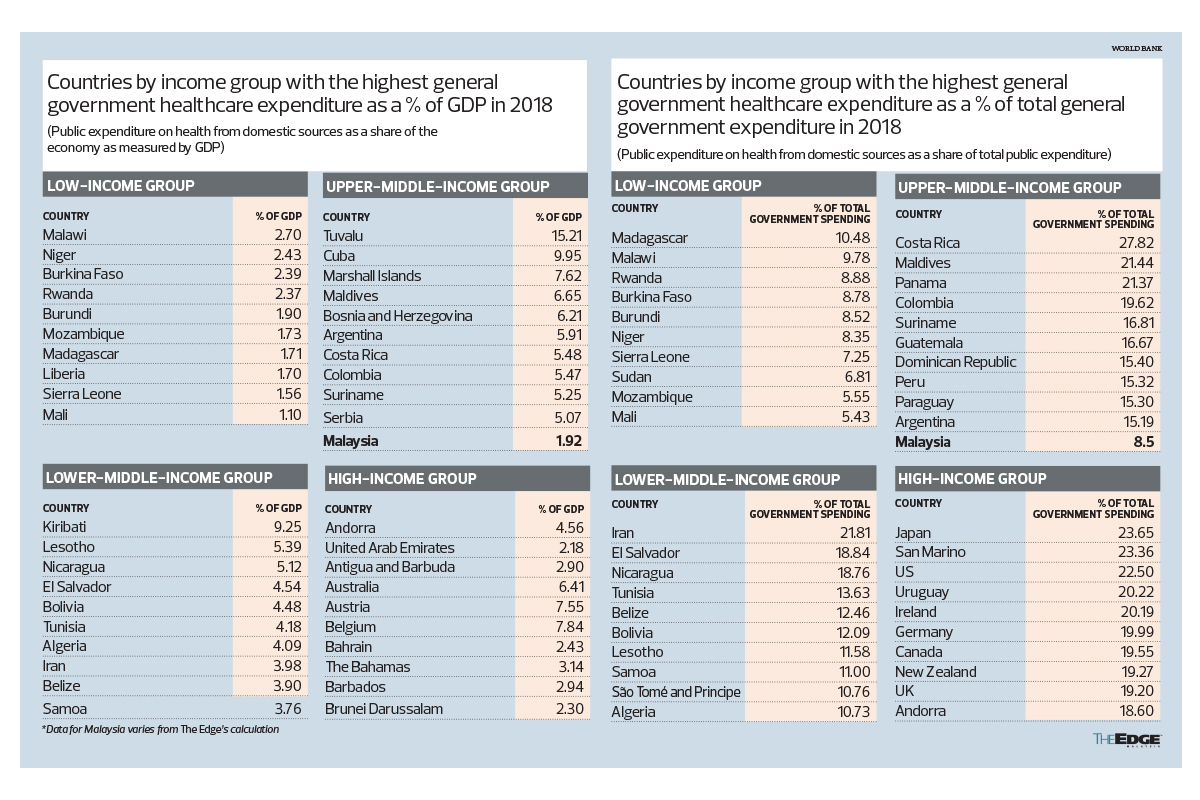
This article first appeared in The Edge Malaysia Weekly on July 26, 2021 - August 1, 2021
IN recent months, the public has been bombarded with news that Malaysia’s public healthcare system is in “critical condition” as Covid-19 admissions swamp hospitals. Meanwhile, social media is flooded with images of the dire situation, including pictures of Covid-19 patients being attended to on the floor at a major hospital that has run out of beds.
Against this backdrop, one cannot help but wonder whether the country has put enough financial resources into the public healthcare system, especially for this long-drawn-out pandemic.
Recall that after Budget 2021 was unveiled last November, the Malaysian Health Coalition was especially vocal about the healthcare allocation. It said the 4.3% increase in the healthcare budget to RM31.9 billion in 2021, excluding the additional funds allocated under the Covid-19 Fund, was insufficient.
The coalition had earlier called for the healthcare allocation to be raised to 4% of gross domestic product (GDP).
An analysis of public healthcare spending over the last 10 years shows the number in absolute terms rising 82%, from RM16.85 billion in 2011 to RM31.9 billion in 2021. That is expected, owing to population growth, inflation and the economic progress of the country.
As a percentage of total government spending, the healthcare expenditure allocation has also inched up in the last 10 years, from 7.3% in 2011 to 9.9% in 2021.
However, healthcare allocation as a percentage of GDP has not moved much over the last decade. In 2011, the healthcare allocation, which comprised both development and operating expenditure, worked out to 2.4% of GDP. By 2021, healthcare made up only 2.2% of GDP.
Throughout the 10 years, the number ranged between a low of 2% in 2018 and a high of 2.5% of GDP in 2012 as well as 2013.
Does this mean Malaysia has been underinvesting in the healthcare sector over the last decade?
According to data from the World Bank, which is provided up to 2018, the Malaysian government’s healthcare expenditure does lag behind the average of 3.84% of GDP among upper-middle-income countries.
Note that government healthcare expenditure as a percentage of GDP among upper-middle-income countries ranges widely, with the highest at 15.21% and the lowest at 0.59% in 2018.
Meanwhile, for high-income countries, the average government healthcare expenditure amounted to 5.23% of GDP. Like upper-middle-income countries, government healthcare expenditure ranges widely — between 1.36% and 9.27% of GDP.
In a report titled “Global Spending on Health 2020: Weathering the storm”, the World Health Organization (WHO) highlights that there is no clear correlation between income and percentage of healthcare spending within any income group.
“The policy choices that each country makes in the organisation of its health financing system, as well as differences in epidemiological patterns, have important implications for health spending levels and likely explain much of the observed variation,” it notes.
Take, for example, Thailand, which is in the upper-middle-income country category, like Malaysia. In 2018, World Bank data showed that the country’s government healthcare expenditure amounted to 2.9% of GDP compared with Malaysia’s 2%.
It is worth noting that Thailand and Malaysia finance healthcare differently. Thailand, which achieved universal healthcare in 2002, funds its healthcare through three major insurance schemes — one for government employees and dependants, another for the private sector and the Universal Coverage Scheme (UCS) for the remaining citizens. Only the UCS is funded completely by the government; the other two insurance schemes are on a premium basis.
As for Malaysia, the public healthcare system is financed largely through the federal government revenue, which is derived mainly from taxes. An allocation is made in the budget each year by the Ministry of Finance. It should be highlighted that Malaysia’s public healthcare system is one of the better ones when it comes to affordability for its citizens, with Malaysians paying a minimal amount to receive the necessary treatment.
While the government healthcare expenditure as a percentage of GDP has remained the same over the last decade, government healthcare spending as a share of total government spending has increased slightly.
According to WHO, this metric reflects the priority a government places on health. The average percentage in 2018 was 5.6% in low-income countries, 7.3% in lower-middle-income countries, 11.6% in upper-middle-income countries and 14% in high-income countries.
Malaysia has progressed from 7.3% of total government expenditure in 2011 to 9.3% in 2018. However, the figure is still lower than the average among upper-middle-income countries.
To be fair, the percentage that is below the average of other upper-middle-income countries may not be the best indicator, given the wide range of each income group. Within the upper-middle-income-country group, the number ranged between 3% and 28% in 2018.
It is no different among the high-income-country group as well. Data shows that the Japanese government spends the most on healthcare, at 23.6% of total government expenditure, whereas the Qatari government spends only 6.3% of its total government expenditure on public healthcare.
That said, the overall share of health spending by governments has risen over the years in both upper-middle- and high-income countries.
This is likely to increase further in 2020 and 2021 as governments worldwide procure vaccines and equip their healthcare professionals with more financial resources to fight the pandemic.
In 2020, initial estimates put Malaysia’s healthcare allocation as a percentage of total government expenditure at 10.2%. Budget 2021 shows, however, that the allocation fell to 9.9% as a percentage of the budget. This is because Budget 2021 includes a RM17 billion Covid-19 fund that is separate from the various ministries allocation.
The actual health spending made by the government for 2021 will be known only two years later.
The Covid-19 pandemic has put a strain on healthcare worldwide, including in Malaysia. Even Taiwan, which had been lauded for keeping Covid-19 infection numbers low earlier on, has seen a resurgence in cases. In 2018, the country’s health expenditure amounted to 6.6% of GDP.
Currently, Taiwan is seeing a 7-day average of 22 cases from its peak of 597 in May.
Its success in the early days, notes observers, was due to rigorous testing and contact tracing, isolation of positive cases and quarantining of close contacts. Population-based measures such as the wearing of face masks, physical distancing and avoidance of mass gatherings were effectively implemented.
Now, Taiwan faces a different challenge: The vaccination rate is extremely low, with only 0.7% of its population inoculated. Its success in keeping the virus at bay had prompted many to believe that vaccination was not necessary. There is also widespread distrust of vaccines among the general public.
On the other hand, Malaysia’s vaccination rate has risen dramatically in recent weeks, making it one of the highest in the world. As at July 22, 15.07% of the population were fully inoculated and 32.34% had received at least the first dose.
Save by subscribing to us for your print and/or digital copy.
P/S: The Edge is also available on Apple's AppStore and Androids' Google Play.


